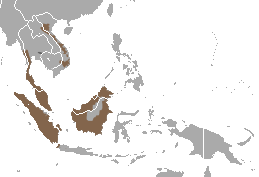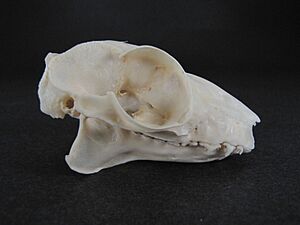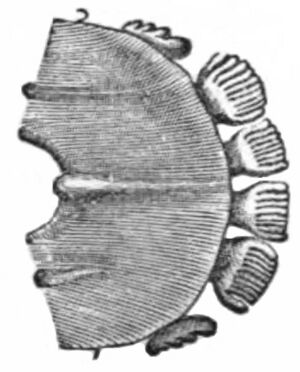Sunda flying lemur facts for kids
Quick facts for kids Sunda flying lemur |
|
|---|---|
 |
|
| Sunda flying lemur | |
| Conservation status | |
| Scientific classification | |
| Genus: |
Galeopterus
|
| Species: |
variegatus
|
 |
|
| Sunda flying lemur range | |
| Synonyms | |
|
|
The Sunda flying lemur (Galeopterus variegatus) is also known as the Malayan flying lemur or Malayan colugo. It is the only colugo species in its group, Galeopterus.
These amazing animals live in Southeast Asia. You can find them in places like southern Myanmar, Thailand, Vietnam, Malaysia, Singapore, and Indonesia. They are listed as "Least Concern" on the IUCN Red List, which means they are not currently in danger of disappearing.
Even though it's called a "flying lemur," it doesn't actually fly! Instead, it glides gracefully between trees. It spends all its time in trees and is active at night. It eats soft plant parts like young leaves, shoots, flowers, and fruits. This animal really depends on forests to live.
The Sunda flying lemur is protected by laws in its home countries. Sadly, they sometimes face threats like losing their homes. This happens when forests are cut down, especially in developing countries like Malaysia.
Contents
What is a Sunda Flying Lemur?
Sunda flying lemurs are excellent climbers. However, they are almost helpless if they land on the ground. They have a special skin flap called a patagium. This skin connects from their neck, goes along their arms and legs, and even reaches their fingertips and toes. This kite-shaped skin helps them glide.
They can glide for long distances, sometimes over 100 meters (about the length of a football field)! When they glide, they only lose a little bit of height. They also have special feet that help them climb trees easily and quickly. This helps them find food and stay safe from animals that might hunt them.
How Big Are They?
A Sunda flying lemur's body, from head to tail, is about 33 to 42 centimeters (13 to 16.5 inches) long. Their tail is about 18 to 27 centimeters (7 to 10.5 inches) long. Their back legs are about 6.5 to 7.3 centimeters (2.5 to 2.9 inches) long. They usually weigh between 0.9 to 1.3 kilograms (2 to 2.9 pounds).
Where Do They Live?
The Sunda flying lemur lives across a wide area in Southeast Asia. You can find them on the mainland and on many islands. Their homes include northern Laos, Cambodia, Vietnam, Thailand, Malaysia, Singapore, Brunei, and Indonesia. The Philippine flying lemur is a different kind of colugo that only lives in the southern Philippines.
These lemurs can live in many different types of places. They are found in gardens, old and new forests, rubber and coconut farms, fruit orchards, and even swampy areas. They live in both lowlands and mountainous regions. However, not all these places can support a large number of colugos.
Daily Life and Habits
Sunda flying lemurs are mostly active at night. Sometimes, you might see them moving around in the morning or afternoon too.
They are very skilled at gliding and can steer themselves in the air. But strong rain and wind can make it harder for them to glide. They usually glide in open areas or high up in the trees, especially in thick tropical rainforests. They need enough space to glide and land safely to avoid getting hurt.
Interestingly, shorter glides can lead to harder landings. Longer glides often result in softer landings because they can slow themselves down in the air. Being able to glide helps colugos reach food sources that are spread out in the rainforest. It also helps them avoid predators that live on the ground or in the trees.
Sunda flying lemurs often look for food in the tops of trees. They might visit several different tree types in one night, or sometimes just one type.
What Do They Eat?
Their main food is leaves. They usually pick leaves that have less potassium and nitrogen, but more tannin. They also eat buds, shoots, flowers from coconut and durian trees, fruits, and sap from certain trees. In Sarawak, Malaysia, they have also been seen eating insects. The food they choose depends on where they live, what kind of habitat it is, and what food is available.
They have also been seen licking the bark of certain trees. They do this to get water, nutrients, salts, and minerals.
Reproduction
Female Sunda flying lemurs carry their babies for about 60 days. After this time, a single baby is born. The mother carries her baby on her belly, holding it with her large skin membrane.




